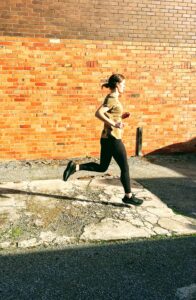Postnatal Return to Running: Where to start & how to progress
Running is a great form of cardio. It elevates the heart rate, is time efficient, gives a strong endorphin rush and mood boost, is cost effective, and can be done solo or as part of a community group.
When it comes to the postnatal period, returning to some form of exercise safely, including returning to running, can be a tricky journey to navigate. If it is not done correctly then we can risk creating more harm than good to our bodies such as the onset of low back / pelvic girdle / hip pain, or pelvic floor symptoms such as bladder or bowel leakage.
So, when is the right time to start?
How quickly can you build up your distance and speed?
And when do you know if you are pushing your body too hard?
…These are all questions that a physiotherapist who has experience dealing with women’s health can help with.
The most important point to remember when returning to running is that an individualised approach is necessary. There are general guidelines out there, but just like every pregnancy, labour, and birth experience varies, the journey of post-natal recovery and returning to higher impact exercise is going to be different for us all.
Regardless of whether you have had a caesarian section or natural birth, large loads are put on the pelvic floor muscles and connective tissue during pregnancy alone due to increasing weight of the baby and hormonal changes. It is therefore extremely important to allow enough time for your connective tissues to heal and to strengthen the pelvic floor muscles before putting them under higher loads. High impact exercise has been found to have a 4.59 fold increased risk of pelvic floor dysfunction compared to low impact exercise (De Mattos Lorenco et al., 2018). It is important to listen to the body and receive some guidance from a trained health professional as to the most appropriate time for you to progress from low intensity to high intensity, particularly if you are experiencing any pelvic floor symptoms such as pain, heaviness, dragging, or incontinence (Goom, Donnelly, & Brockwell, 2019).
When should you first have an assessment by a physiotherapist?
The most current Returning to Running Postnatal guidelines suggest having a 6-week postnatal assessment by a specialised physiotherapist in order to assess the deep abdominal and pelvic floor muscles, receive individualised advice, and get clearance to begin low intensity exercise. This includes activities such as walking or Mum’s & Bub’s pilates classes which we offer at Inner Strength of Bayside.
Musculoskeletal pain, urinary incontinence, abdominal separation (Blyholder et al. 2016) and pelvic organ prolapse (POP) are prevalent conditions amongst postnatal runners, therefore low intensity exercise should be carried out for a period of at least 12-weeks post-natal before considering higher intensity exercise such as running. This is regardless of your previous running experience or physical ability.
In considering the pelvic floor you should be able to complete all of the below in standing as a baseline prior to commencing running:
- 10x fast reps
- 8-12 reps of 6-8 second maximum contractions
- 60 seconds submaximal 30-50% contraction
How can you receive clearance to begin ‘returning to running’ safely?
Once you have done at least 12-weeks of low intensity exercise and strengthening, there are a series of criteria and functional tests that we as physiotherapists can take you through in order to determine whether you are ready to begin running such as:
- Walking 30 mins
- Single leg sit to stand out of chair x10
- Jogging on the spot for 1 minute
- 10 forward bounds
Taking you through these functional assessments within the clinic also helps to identify whether there are specific areas in the body that we need to continue to strengthen or monitor whilst you progressively increase your running distance. This will reduce the likelihood of injury and allow you to stay consistently active to build your fitness back up.
Here at the clinic, our physiotherapists often recommend using the Couch to 5K app to safely build up your running distance and training frequency in order to reduce the likelihood of injury. It is easy to use and allows you to tailor your running plan based on age, past experience, current activity levels, time available etc.
We also recommend having a well-fitted pair of running shoes, ensuring you have had sufficient hydration at least 1-2 hours prior to running, and incorporate some form of mobility / stretches post-run to look after your body.
If you are within the postnatal period and are thinking of starting to return to running or you know of someone who is, let them know that we are here to help.
A physiotherapy postnatal appointment can either be booked by giving the clinic a call (03) 8555 4099 or book an appointment online at innerstrengthbayside.com.au
Written by Laura Cook, Physiotherapist
De Mattos Lourenco T, Matsuoka P, Baracat C, Haddad J (2018) Urinary incontinence in female athletes: a systematic review. International Urogynecology Journal.
Goom T, Donnelly G, & Brockwell E(2019). Returning to running postnatal – guidelines for medical, health, and fitness professionals managing this population.


